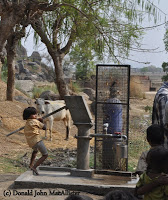Following our post about fluoride contamination last week, our water series is now focused on the equally serious problem of arsenic contamination.
Some arsenic is present in all groundwater sources (see table 1). Of course this is only a problem if the arsenic has the chance to leak into groundwater as it filters through the rock. Arsenic leaching is more likely to occur in groundwater that is hot, oxygen-depleted, alkaline or extremely acidic.
Table 1: table of different geological rock types and their associated arsenic content (from UNICEF arsenic report, 2008)
| Rock or sediment type | Average arsenic content (parts per million) | Range of arsenic content (parts per million) |
| Sandstone | 4.1 | 0.6 – 120 |
| Limestone | 2.6 | 0.4 – 20 |
| Granite | 1.3 | 0.2 – 15 |
| Basalt | 2.3 | 0.2 – 113 |
| Alluvial sand | 2.9 | 1.0 – 6.2 |
| Alluvial silt | 6.5 | 2.7 – 15 |
| Loess | – | 5.4 – 18 |
A 2008 UNICEF report found that over 137 million people in more than 70 countries are probably affected by elevated arsenic levels in their drinking water (above 10 parts per billion is considered a risk to health). Arsenic can be transferred into the body through drinking contaminated water, or eating food that was irrigated using contaminated water.
There is no available treatment for the suite of health problems, collectively known as arsenicosis, caused by the build up of arsenic in the body over several years. Arsenic exposure can cause cancer, as well as vomiting, blindness and paralysis. High arsenic levels are a major problem in SE Asia. In Cambodia concentrations of up to 250 parts per billion have resulted in cases of arsenicosis so severe that amputations are required.

Small child using a well in Bangladesh. Photo taken by Donald John Macallister whilst working on a water project.
Arsenic poisoning can often remain undetected for a long time, as the symptoms do not occur until after a long, slow period of toxin build-up in the body. It is often health workers that have the first opportunity to identify the problem, but many are not trained to recognize the effects of early arsenicosis – lesions on the skin.
Once a high-risk area is identified, water samples can be taken over a wide area to map contaminated wells. The samples can be analysed in the field or sent back to a permanent laboratory. Field testing is cheaper and the results can be conveyed back to the relevant communities immediately, but laboratory testing may be necessary if more precise results are needed.
The most effective way to reduce exposure to arsenic is to identify contaminated wells and explain to the affected communities why they should avoid them. Communicating the severity of arsenic poisoning can be difficult, as arsenic in water can’t be seen or tasted, and there are no immediate consequences of drinking arsenic-contaminated water.
In cases where a local, uncontaminated well cannot be identified, the only option may be to remove arsenic from drinking water by passing it through an ultrafiltration membrane. Polyelectrolytes (long-chained molecules that acts like salt and dissociate in water) form complex molecules with arsenic that are too large to pass through the membrane. These large molecules form more efficiently at higher pH (8.5), as arsenic becomes more negatively charged (-2) and so is more attracted to the positive polyelectrolyte. Conveniently, groundwater often has a slightly elevated natural pH. The filter should have grains with a high surface area and high absorptive capacity. Goethite amended sand works well, with added iron oxide.
Filtering out arsenic can cause the concentration of other elements to drop as well, some of which, such as chromium, may be beneficial. It is always more desirable to source water from an alternative well than to filter water from an existing well.
UNICEF have produced an excellent and extensive report documenting their knowledge and experience of working with arsenic contaminated wells. To learn more, you can read it for free online.


